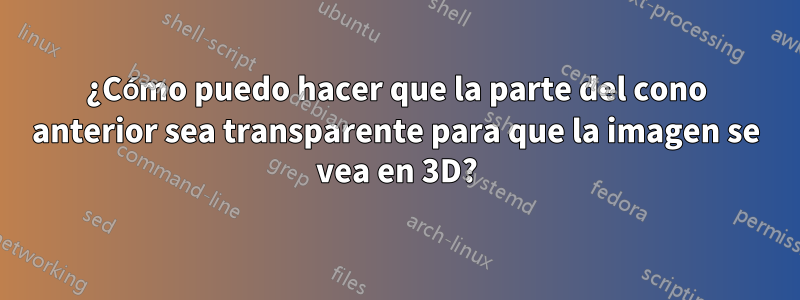
¡Recientemente comencé con tikz y no tengo ni idea de cómo puedo hacer que la parte etiquetada sea transparente! Espero que alguien pueda ayudarme. gracias de antemano
\usepackage{tikz,tikz-3dplot}
\tdplotsetmaincoords{80}{45}
\tdplotsetrotatedcoords{-90}{180}{-90}
\begin{document}
\begin{figure}[!h]
\centering
\tikzset{surface/.style={draw=blue!70!black, fill=blue!40!white, fill opacity=.6}}
\newcommand{\coneback}[4][]{
\draw[canvas is xy plane at z=#2, #1] (45-#4:#3) arc (45-#4:225+#4:#3) -- (O) --cycle;
}
\newcommand{\conefront}[4][]{
\draw[canvas is xy plane at z=#2, #1] (45-#4:#3) arc (45-#4:-135+#4:#3) -- (O) --cycle;
}
\begin{tikzpicture}[tdplot_main_coords, grid/.style={help lines,blue!40!white,opacity=0.2},scale=1]
\coordinate (O) at (0,0,0);
\fill[blue!40!white,opacity=0.5] (-4,-4,0) -- (-4,4,0) -- (4,4,0) -- (4,-4,0) -- cycle;
\foreach \x in {-4,...,4}
\foreach \y in {-4,...,4}
{
\draw[grid] (\x,-4) -- (\x,4);
\draw[grid] (-4,\y) -- (4,\y);
}
\coneback[surface]{-3}{2}{-12}
\conefront[surface]{-3}{2}{-12}
\draw[->] (-4,0,0) -- (4,0,0) {};
\draw[->] (0,-4,0) -- (0,4,0) {};
\coneback[surface]{3}{2}{12}
\draw[-,dashed] (0,0,-2.65) -- (0,0,2.65) node[above] {};
\draw[-,dashed] (0,0,-4) -- (0,0,-3.35) node[above] {};
\draw[->,dashed] (0,0,3.35) -- (0,0,4) node[above] {$time$};
\conefront[surface]{3}{2}{12}
\fill (4,0,2) circle (2pt) node[above right] {$C$};
\fill (0,0,0) circle (2pt) {};
\fill (-0.5,-0.85,2.2) circle (2pt) node[above left] {$A$};
\fill (1.3,0.5,2) circle (2pt) node[above left] {$B$};
\draw[->,red] (0,0,0) -- (4,0,2) node[below, pos=0.6, rotate=26.5651,scale=0.70,black] {$\textbf{spacelike vector}$};
\draw[->,red] (0,0,0) -- (1.3,0.5,2) node[below, pos=0.65, rotate=55.1459,scale=0.70,black] {$\textbf{lightlike vector}$};
\draw[->,red] (0,0,0) -- (-0.5,-0.85,2.2) node[above, pos=0.57, rotate=-65.8557,scale=0.70,black] {$\textbf{timelike vector}$};
\node[black] at (0,0,3) {$Future\,\,Light\,\,Cone$};
\node[black] at (0,0,-3) {$Past\,\,Light\,\,Cone$};
\node[black] at (0,0.05,0.3) {$O$};
\node[black] at (0,4.7,0) {$space$};
\node[black] at (5,-0.3,0) {$space$};
\end{tikzpicture}
\caption{Light Cone in 2d Space plus a Time Dimension}
\label{cone}
\end{figure}
Respuesta1
Dibuja el cono inferior primero. Luego dibuja el plano y luego el cono superior. Cambiar la combinación de colores también puede ayudar, ya que el azul sobre azul hace que sea más difícil ver lo que hay delante. Puedes delinear el plano para dar contraste adicional. Por último, dividiría el eje del tiempo para que la última mitad se dibuje antes del avión.
\begin{figure}[!h]
\centering
\tikzset{surface/.style={draw=blue!70!black, fill=blue!20!white, fill opacity=.6}}
\newcommand{\coneback}[4][]{
\draw[canvas is xy plane at z=#2, #1] (45-#4:#3) arc (45-#4:225+#4:#3) -- (O) --cycle;
}
\newcommand{\conefront}[4][]{
\draw[canvas is xy plane at z=#2, #1] (45-#4:#3) arc (45-#4:-135+#4:#3) -- (O) --cycle;
}
\begin{tikzpicture}[tdplot_main_coords, grid/.style={help lines,violet!40!white,opacity=0.5},scale=1]
\coordinate (O) at (0,0,0);
\coneback[surface]{-3}{2}{-12}
\conefront[surface]{-3}{2}{-12}
\fill[violet!40!white,opacity=0.5] (-4,-4,0) -- (-4,4,0) -- (4,4,0) -- (4,-4,0) -- cycle;
\foreach \x in {-4,...,4}
\foreach \y in {-4,...,4}
{
\draw[grid] (\x,-4) -- (\x,4);
\draw[grid] (-4,\y) -- (4,\y);
\draw[violet] (-4,4)--(-4,-4)--(4,-4)--(4,4)--cycle;
}
\draw[->] (-4,0,0) -- (4,0,0) {};
\draw[->] (0,-4,0) -- (0,4,0) {};
\coneback[surface]{3}{2}{12}
\draw[-,dashed] (0,0,-2.65) -- (0,0,2.65) node[above] {};
\draw[-,dashed] (0,0,-4) -- (0,0,-3.35) node[above] {};
\draw[->,dashed] (0,0,3.35) -- (0,0,4) node[above] {$time$};
\conefront[surface]{3}{2}{12}
\fill (4,0,2) circle (2pt) node[above right] {$C$};
\fill (0,0,0) circle (2pt) {};
\fill (-0.5,-0.85,2.2) circle (2pt) node[above left] {$A$};
\fill (1.3,0.5,2) circle (2pt) node[above left] {$B$};
\draw[->,red] (0,0,0) -- (4,0,2) node[below, pos=0.6, rotate=26.5651,scale=0.70,black] {$\textbf{spacelike vector}$};
\draw[->,red] (0,0,0) -- (1.3,0.5,2) node[below, pos=0.65, rotate=55.1459,scale=0.70,black] {$\textbf{lightlike vector}$};
\draw[->,red] (0,0,0) -- (-0.5,-0.85,2.2) node[above, pos=0.57, rotate=-65.8557,scale=0.70,black] {$\textbf{timelike vector}$};
\node[black] at (0,0,3) {$Future\,\,Light\,\,Cone$};
\node[black] at (0,0,-3) {$Past\,\,Light\,\,Cone$};
\node[black] at (0,0.05,0.3) {$O$};
\node[black] at (0,4.7,0) {$space$};
\node[black] at (5,-0.3,0) {$space$};
\end{tikzpicture}
\caption{Light Cone in 2d Space plus a Time Dimension}
\label{cone}
\end{figure}



